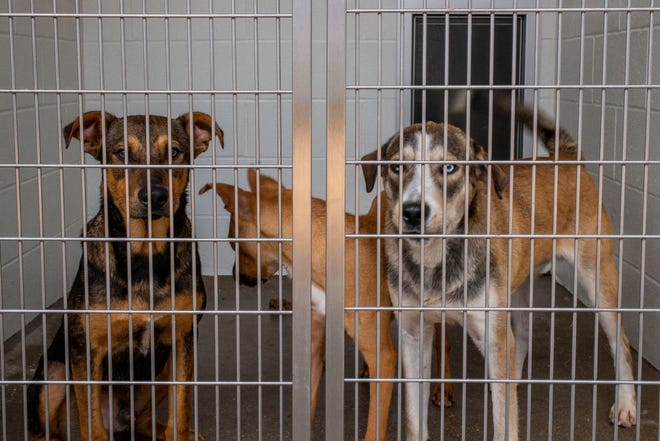Animal welfare organizations are bracing for another kind of impact when student-loan payments resume for millions of borrowers next month: While people are facing another monthly bill they potentially can’t afford, their pets are staring down the possibility of losing their homes.
Shelters have already had it rough in the past few years, with many now existing in an ongoing status of crisis. Shelters and rescues have seen more animals coming in than leaving, especially in the years since the onset of the pandemic, leaving them at a critical level of resource strain.
According to Shelter Animals Count, a nonprofit working with more than 7,000 rescue organizations nationwide and creators of The National Database of sheltered animal statistics, shelters are in their third year having too many animals and not enough adoptions. Dog adoptions especially have slowed down and are forecasted to remain flat or even dip below 2022 numbers. This poses a big problem, as dogs account for most of the 4% increase in shelter intake thus far in 2023; as of June, dog intake was up 15% compared to 2021.
Executive Director Stephanie Filer said that when her team began digging into trends, they found economic hardship to be one of the driving factors behind the overcrowding.
“What we were hearing from our partner shelters is that the reasons that animals were being surrendered were really starting to shift about a year a year and a half ago to be more economic based reasons,” Filer told USA TODAY. “So, we were seeing a trend follow where there was food insecurity and unaffordable housing challenges and we started to see those challenges also reflected in the animals that were arriving at the shelters.”
Clear the shelters:‘Born again in dogs’: How Clear the Shelters became a year-round mission for animal lovers
More pet owners are likely to struggle
Many Americans are already struggling in the 2023 economy, thanks in part to two years of high inflation which hit a four-decade high of 9.1% in June 2022. While that number has cooled a bit in the past year, prices are still rising – at a rate of 3.2% in July – and Americans aren’t likely to see significant improvement anytime soon. In fact, many have already taken to lifestyle changes to survive, delaying medical treatment or roughing bad weather by using fewer utilities.
This is concerning, said Filer, because economic distress was already causing more animals to end up at shelters. Of the over 40 million Americans saddled with student loan debt, a survey by US News and World Report found that 85% of borrowers think they’ll face financial hardship due to repayment, and 49% said they’ll have a hard time paying other bills.
This added stressor of more payments, which are estimated to be $503 a month on average according to the Education Data Initiative, has a good chance of triggering a ripple effect for the 86.9 million American homes that have pets, according to statistics compiled by Forbes.
“For all the financial stressors already affecting pet owners, it’s worrisome to imagine the consequences of 40 million people with another significant payment each month. This could trigger another wave of pet owners giving up – or considering giving up – their pets because they feel unable to care for them,” Filer said.
While recue organizations are doing their best to prepare, Filer said that this could not come at a worse time for shelters, which are way over capacity across the country.
“Whether it’s a natural disaster or a big economic event that impacts millions of people, shelters are already at their breaking point, so adding anything else to it right now is really the fear,” she said. “As shelters look ahead, they are kind of doing what they’ve been doing all along because they really have been in crisis. So, the big call to action is for people to really rally behind their shelters.”
How you can prepare and lend a hand
Cost of owning a dog:How much does a dog cost per year?
Shelters need help more than ever, Filer said, even if the forecast for an uptick in surrenders doesn’t come true. And there are a lot of ways to help if you’re interested.
Volunteer: Most rescues and shelters are always looking for more volunteers to perform a variety of tasks, from helping with adoptions and fundraising to assisting in the building itself with cleaning, feeding and socializing resident animals.
Donate: Many organizations subsist off donations (which are usually tax deductible) and are also often in need of foster homes.
Foster: You not only get to enjoy time with animals you foster said Filer, but you get to help save even more lives than you would just being able to adopt one. Similarly, she said, volunteering provides an opportunity to interact with animals without taking on that full responsibility.
“People who want the companionship of a pet but are worried about if they would be able to afford that pet [have options],” said Filer. “Long-term fostering is a great option because often shelters will provide all of the medical care and food for that animal while they’re in your home.”
Anyone with pets already in their homes should make sure they have a plan in place in case something unexpected happens, Filer also said.
Make sure to get routine and preventive veterinary care on the calendar now, whether that’s a spay or neuter, vaccines, general wellness exams or more complex care like surgeries or dentals.
If you need help from an organization, shelter, rescue or other community resource, sign up now, as many have waitlists.
The best means of combating this issue is ensuring you reach out as soon as you begin to struggle, said Filer, and getting to know the resources available to you in advance of needing them. Ask yourself what would happen if you lost your job, got behind on bills, if your pet suddenly got sick or injured and how much you would be able to afford to pay on your own before needing outside help.
“What we find is that a lot of times when a pet makes its way to a shelter because the family has to surrender the pet, it’s usually after they have waited to the last possible minute,” she said. “Obviously making that choice is heartbreaking and they don’t want to do it a minute before they have to. And unfortunately, when that happens, there’s usually not a lot of intervention that can be done.”
Ultimately, said Filer, shelters need your help more than ever, even if student loans don’t have as large an impact as anticipated.
“We can’t predict what’s ahead for sure, but this is very concerning,” Filer said. “But even if that does not pose the problem, please still go out and support your local shelters because they are really, really struggling right now.”
Pet insurance pricing:How much does pet insurance cost in September 2023?
Cost of owning a cat:What’s the cost of owning a cat?
How to get help
- Look for discounts on pet supplies – Many online pet supplies stores such as Chewy offer sales, discount codes and features like subscribe and save or autoship. Stock up when things are on sale and sign up for rewards programs and text or email alerts to make sure you don’t miss out on any deals.
- Keep an eye out for gifted supplies – Like many other products, there are often people looking to give away pet supplies. Sometimes an animal doesn’t like a new brand of food, a new kind of cat litter, or shows no interest in that bed or toy their pet parent purchased them. Neighborhood apps like Nextdoor, social media sales pages like Facebook marketplace and online “buy nothing groups” often have people looking to get rid of extra pet supplies for free or cheap.
- Find your local options for spay/neuter and vaccines – Most communities have some kind of low-cost clinic or program for basic veterinary care, specifically vaccines and spaying/neutering. Do a search for your local low-cost, high-volume clinic, which are sometimes directly affiliated with a shelter or vet’s office. Many of these offer not only spaying and neutering but vaccines and even dental care, and many have options like sliding scale rates, discounts for students or seniors or other additional cost-saving promotions. Shelters often have their own shot clinics at discounted or sliding scale rates as well. Always call ahead of time to make an appointment, as these programs often book out weeks or months in advance.
- Get help with emergency medical care – Pet medical care can be expensive, especially if you end up in an unexpected situation. There are many options and organizations that might be able to help. Besides searching for direct assistance through national databases like pets.findhelp.com, those hit with unexpected expenses can speak with their vet about payment options or apply for a financing plan through programs like Care Credit, which can be used at most veterinary offices. There are also many different options for pet insurance, which can help cover large and unexpected veterinary bills for a low monthly cost.
- Locate local food pantries – Food insecurity can happen not only to people, but their pets as well. Human food pantries often have some pet supplies available, but more shelters have begun to stock their own pet-specific pantries. Many of these donation-based programs have sprung up since the beginning of the pandemic, as just a few bags of food can often make the difference between a pet staying or losing their home.
- Familiarize yourself with area retention programs – Many shelters and rescues also have resources meant to help people struggling with caring for their pet. Programs vary from place to place, but they are designed to help people in crisis keep their beloved pets with them instead of being forced to surrender them. Assistance can come in the form of medical care, behavioral training, a temporary foster home, pet care supplies, lists of pet-friendly affordable housing and even help with installing or repairing fences for your pet’s safety.
- Know the benefits of adopting vs. purchasing a pet – If you’re thinking about bringing a new pet home, startup costs can be a bit hefty. Adoption is generally a markedly more affordable option than buying from a shop, breeder or online seller, as shelter and rescue animals generally come already spayed or neuter, vaccinated, vetted and even microchipped. These services alone can and usually do cost hundreds of dollars, meaning adoption not only saves a live but saves you money.
Read the full article here














